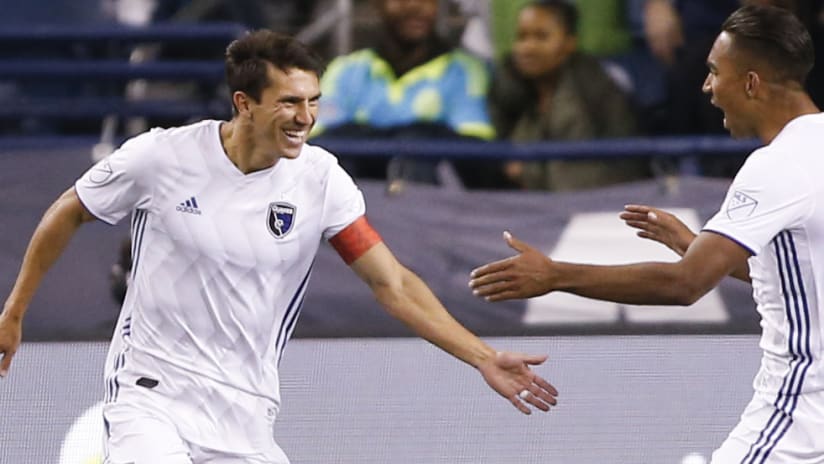On the see-saw of embarrassing to impressive, the San Jose Earthquakes dropped like gallon of milk to open the season. They started 0-4-0 with a minus-12 goal differential. The best strategy in MLS Fantasy throughout the first month was to pick as many players as possible who were playing the Quakes.
But after a 5-0 demolition at the hands of Carlos Vela and LAFC, the Earthquakes have recovered to some degree. Across their last four games, they are 2-1-1, with a 3-0 win over Portland, a 4-1 win over Sporting Kansas City and a 2-2 draw at Seattle. That’s a nice stretch.
Now that the lever’s back to square, where do the Quakes go next?
San Jose, as I’m sure you’ve read or heard at this point, man-mark all of the field. Nine of the 10 field players pick a player and stay with that player...everywhere he goes. The opposing right winger moves to the left sideline? The Quakes left defender runs with him to the other side. The opposing center mid goes to get a hot dog? The Quakes center mid grabs the ketchup for him.
The system, I feel fairly confident suggesting, makes zero tactical sense. The entire point of tactics is that 11 branches bundled together are tougher to break than a single twig. Matias Almeyda’s system drops 11 twigs on the field and tells them to hold strong.
Its only main advantage is the element of rarity and surprise. Everything players do on the field comes from muscle memory; professional players have seen millions of pictures on a soccer field throughout their lives, and their brains have stored those pictures to know what to do when the arrangement arrives again. The picture they haven’t seen before? The center mid pushing the condiment nozzle for his counterpart.
Similarly, teams set up their tactics to play against the style they usually see. Twenty-three of the 24 teams in MLS play in a zonal defense, so teams prepare all preseason to play against a zonal defense. When the week of the San Jose game comes, they have little time to figure it out. If you gave a team two weeks to prepare to play a man-marking system, they could outwit it almost every time. But nobody has two weeks to prepare midseason.
Almeyda is banking on two things happening. First, the other team gets shook by San Jose’s tactics and lose their own coherent 11-person plan. Then the game turns into 1-on-1 all over the field, and Almeyda’s players, who are both more suited (ideally) to and more used to individual duels, win said duels. There’s one fact about soccer you should never forget: Intensity beats skill when the skill can’t match, or gets frazzled by, the intensity.
In the first four games, the other team neither fell into San Jose’s trap nor did San Jose win the individual contests when they came. In three of the last four games, however, the ‘Quakes have been able to check both boxes.
Portland, Kansas City, and Seattle adjusted from their usual concepts. Portland attempted to beat the man-marking system by dribbling past players, but for all Diego Valeri, Sebastian Blanco, and Diego Chara offer, they are not 1-on-1 players. SKC couldn’t find their usual openings in possession, so Ilie Sanchez moved away from the middle to create more space for his teammates. It worked at creating more space, but SKC couldn’t find out what to do without Ilie pulling the strings.
That led Seattle head coach Brian Schmetzer, who I’m pretty sure had never made a specific non-formation adjustment for a game since he took over in 2016, to take a proactive approach on Wednesday night. He started with Nico Lodeiro as the center striker, hoping to use his movement to pull out the center back man-making him; Jordan Morris would then sprint into the open space. He also had center back Kim Kee-Hee step into midfield when the Sounders progressed. Remember, San Jose mark nine of the 10 players on the field, and the opposing center back is usually the 10th.
“Hopefully Kim would find some space and bring the ball forward,” Schmetzer told reporters after the game. “[It] would start a chain reaction [where] … whoever comes to put pressure on Kim has to release from him man, and we were trying to get an advantage from that situation.”
Both moves make total logical sense. They also fell straight into what San Jose want: make the other team adjust, make them do things they aren’t used to doing, lessen their ability to execute, make the game chaotic and then win the chaos. To San Jose’s credit, they have started to win the chaos.
The players have started to figure out their own system. They are always a little closer to the opponent, a little more aggressive, and a lot more confident. Shea Salinas, Cristian Espinoza, Danny Hoesen, Jackson Yueill, Florian Jungwirth and Harold Cummings have all put together their best performance in a Quakes’ jersey. The system that makes no sense has been giving teams problems.
San Jose fans have read this far and really just want to know one thing: Does this mean the Quakes have a chance to make the playoffs?
I don’t have an answer for you, and they are definitely trending upward. The Western Conference, though, is stacked this year. Houston, who are 4-1-1, might be only the seventh-best team. But at the very least, I expect San Jose to be in the picture.













